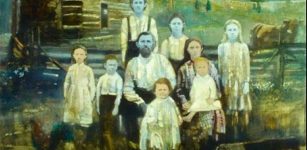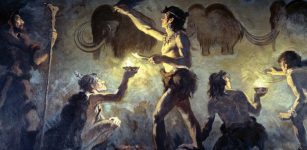Kikimora – Nightly Evil Female Spirit And Goddess Of Chickens In Slavic Beliefs
A. Sutherland - AncientPages.com - Ancient beliefs say that Kikimora spirits (there are many of them) probably live in every household. However, in some versions of her story, she usually appears in homes of dysfunctional, unhappy families where abuse, quarrel, and screams occur daily.
Swamp Kikimora, after which the spider Kikimora palustris is named. Art work by symbolist
painter Vasiliy Ivanovich Denisov (1862–1922).
Kikimora originates in Slavic folklore. In the ancient beliefs of the East Slavs, there are two different kinds of Kikimoras.
One dwells in the forest and is married to the Domovik (Domovoi). The other one comes from the swamp and is married to Leshy.
Kikimora sleeps in dark places of the home, usually in the cellar or behind the furnace, and during the nights, she comes out and works with weaving, spinning, and needlework.
If the home is well kept, Kikimora is happy with the family. She helps them with housework, guards the family members, and protects the chickens. Generally, Kikimora likes skillful and hard-working women that perform their traditional work at home.
An angry and displeased Kikimora may be a troublesome spirit for the family because she interferes in people's lives, disturbs their sleep (mainly irritating children), and makes noises by scratching and whistling at night. She also moves and throws objects, makes them disappear, or changes their places.
Appearance Of Kikimora And Her Psychic Abilities
She is an evil spirit in the form of a small woman with a thimble head, long flowing hair, chicken feet, a body as thin as a straw, and a face, which is almost human-like but shapeless. Kikimora could quickly become invisible.
Illustration of a Kikimora (1934) by Ivan Bilibin (1876-1942). (Kikimora as house-spirit and guardian of chickens - hence her depiction in chicken-like form). Image credit: Ivan Bilibin - Public Domain
Despite her small size, she is a powerful spirit with psychic abilities that help to warn her family of a disaster or dangerous enemies approaching the house where she lives. In other words, she first delivers warnings of misfortune rather than good news.
However, she can be a challenging spirit to work with and keep happy. Once Kikimora is inside the house, it is difficult to get her to leave.
To encounter Kikimora spinning was believed to be a bad omen of impending death.
Kikimora – A 'Chicken Goddess'
In the beliefs of Slavic people, Kikimora is a goddess of chickens. She guards them but sometimes torments them and can even harm pets. Kikimora wants a well-arranged chicken yard where all chickens laying eggs are protected.
The character of Kikimora became a popular inspiration for authors of fairy tales and musicians like Anatoly Lyadov (1855 -1914), a composer and a teacher. He wrote that Kikimora "grows up with a magician in the mountains. From dawn to sunset, the magician's cat entertains Kikimora with beautiful tales of ancient times and distant places as she rocks in a crystal cradle.
She spends her first seven years living in a magician's mountain cave, and after seven years, she leaves the cave to go live among people.
In his poem "Kikimora," Lyadov describes this house spirit as a tiny brown witch with a thimble-sized head and a body no wider than a straw.
Written by – A. Sutherland - AncientPages.com Senior Staff Writer
Updated on March 4, 2023
Copyright © AncientPages.com All rights reserved. This material may not be published, broadcast, rewritten or redistributed in whole or part without the express written permission of AncientPages.com
Expand for referencesMacculloch, J. A.. The Mythology of All Races Vol 3
Leeming, D. The Oxford Companion to World Mythology
Ivanits Linda J. Russian Folk Belief
More From Ancient Pages
-
 Remains Of 1,600-Year-Old Roman City Of Neapolis Devastated By A Tsunami Discovered
Archaeology | Sep 7, 2017
Remains Of 1,600-Year-Old Roman City Of Neapolis Devastated By A Tsunami Discovered
Archaeology | Sep 7, 2017 -
 World’s Oldest Hand And Footprints Discovered On The Tibetan Plateau Are 226,000-Year-Old!
Archaeology | Sep 15, 2021
World’s Oldest Hand And Footprints Discovered On The Tibetan Plateau Are 226,000-Year-Old!
Archaeology | Sep 15, 2021 -
 Ancient Manuscript In Museum Reveals Discovery Of Objects Unknown To Modern Science – Coptic Secrets And Guardians Of Treasures – Part 2
Featured Stories | Apr 11, 2021
Ancient Manuscript In Museum Reveals Discovery Of Objects Unknown To Modern Science – Coptic Secrets And Guardians Of Treasures – Part 2
Featured Stories | Apr 11, 2021 -
 Ancient Irish Practiced Special Burial Rituals Such As Dismemberment Of Bodies
Archaeology | Sep 18, 2017
Ancient Irish Practiced Special Burial Rituals Such As Dismemberment Of Bodies
Archaeology | Sep 18, 2017 -
 Armenians’ Origin Theory By Herodotus Debunked By New DNA Study
DNA | Nov 27, 2024
Armenians’ Origin Theory By Herodotus Debunked By New DNA Study
DNA | Nov 27, 2024 -
 Mysterious Deaths In A Dangerous Valley May Be Related To Ancient Events
Featured Stories | Mar 14, 2022
Mysterious Deaths In A Dangerous Valley May Be Related To Ancient Events
Featured Stories | Mar 14, 2022 -
 Who Were The Blue People Of Kentucky?
Featured Stories | Apr 5, 2022
Who Were The Blue People Of Kentucky?
Featured Stories | Apr 5, 2022 -
 Mystery Of The Haraldskærkvinnan (Haraldskærwoman) – Bog Body Of A Viking Queen?
Featured Stories | Apr 8, 2024
Mystery Of The Haraldskærkvinnan (Haraldskærwoman) – Bog Body Of A Viking Queen?
Featured Stories | Apr 8, 2024 -
 Neolithic Farmers Invented Methods To Fight Pests 8,000 Years Ago
Archaeology | Jun 30, 2022
Neolithic Farmers Invented Methods To Fight Pests 8,000 Years Ago
Archaeology | Jun 30, 2022 -
 Similarities And Differences Between Living Spaces Of Neanderthals And Homo Sapiens
Archaeology | Apr 9, 2024
Similarities And Differences Between Living Spaces Of Neanderthals And Homo Sapiens
Archaeology | Apr 9, 2024 -
 Fabel: World’s First Archaeology Dog Helps To Unravel The Mystery Of Sandby Borg
Archaeology | May 10, 2016
Fabel: World’s First Archaeology Dog Helps To Unravel The Mystery Of Sandby Borg
Archaeology | May 10, 2016 -
 First Carbon-Based Paleolithic Paintings Found In Font-De-Gaume Cave, France Could Be 19,000 Years Old
Archaeology | Dec 29, 2023
First Carbon-Based Paleolithic Paintings Found In Font-De-Gaume Cave, France Could Be 19,000 Years Old
Archaeology | Dec 29, 2023 -
 The Phoenicians – And Their Great Experience As Sea Traders
Civilizations | Sep 6, 2015
The Phoenicians – And Their Great Experience As Sea Traders
Civilizations | Sep 6, 2015 -
 Secrets Of The Chephren Pyramid And Its Unknown Mysterious Force
Featured Stories | Mar 20, 2015
Secrets Of The Chephren Pyramid And Its Unknown Mysterious Force
Featured Stories | Mar 20, 2015 -
 Unknown Lost Civilization Of Ancient Megalithic Super-Builders In The Middle East – Can Prehistoric Rock Art Solve The Mystery?
Featured Stories | Jul 13, 2020
Unknown Lost Civilization Of Ancient Megalithic Super-Builders In The Middle East – Can Prehistoric Rock Art Solve The Mystery?
Featured Stories | Jul 13, 2020 -
 Old Royal Crime – Dark Riddle Of Young Princes In The Tower Of London
Featured Stories | Jun 14, 2020
Old Royal Crime – Dark Riddle Of Young Princes In The Tower Of London
Featured Stories | Jun 14, 2020 -
 Unexpected Discovery Of Roman Baths Under Split City Museum In Croatia
Archaeology | Dec 7, 2023
Unexpected Discovery Of Roman Baths Under Split City Museum In Croatia
Archaeology | Dec 7, 2023 -
 Centuries-Old Hidden Tunnels Will Be A New Tourist Attraction In Turkey
Archaeology | Apr 27, 2020
Centuries-Old Hidden Tunnels Will Be A New Tourist Attraction In Turkey
Archaeology | Apr 27, 2020 -
 India’s Mysterious Stonehenge: Prehistoric Complex Of Gigantic Standing Stones Of Willong Is An Enigma
Featured Stories | Jul 30, 2016
India’s Mysterious Stonehenge: Prehistoric Complex Of Gigantic Standing Stones Of Willong Is An Enigma
Featured Stories | Jul 30, 2016 -
 Abu Dhabi Fossil Dunes May Have Inspired The Ancient Great Flood Story – Professor Says
Archaeology | Jul 10, 2022
Abu Dhabi Fossil Dunes May Have Inspired The Ancient Great Flood Story – Professor Says
Archaeology | Jul 10, 2022


